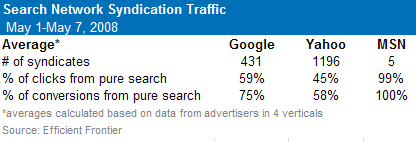How do ad networks that nobody has ever heard of create enough inventory to pull in premium advertisers? It’s simple: create it!
A recent MediaPost article was titled Half Of Ad Impressions, 95 Percent Of Clicks Fraudulent. From that article:
Many of the sites in these exchanges use multiple layers of I-frames, which further complicated efforts to track campaigns. Sites are able to hide fraudulent traffic behind numerous layers of nested I-frames, leaving advertisers blind to in-view data, according to the study.
Mpire believes the default trafficking behavior of many RON buys is to include fraudulent and well-known botted sites. Gluck writes in the study that not all marketplace or exchange traffic is bad, but rather simply includes nefarious inventory that ad networks could block, but for some reason do not.
If you are a legitimate advertiser using these networks, they are stealing your money. If you are a legitimate publisher your inventory is being priced down because it is being priced against, compared against, and often sold in a bundled package with pure fraud. Even if you choose not to sell ads in the ad exchanges, your media is still being compared against the garbage, and the garbage is driving down the perceived value of your inventory. Thus many of these ad exchanges are a perfect mixture of the tragedy of the commons and a market for lemons.
A few years ago I remember listening to a sleazy affiliate marketer talking about how mixing your traffic in with other traffic was a benefit. No wonder, as guys like him were working the iframes + pushing cookies + using bots to view pages and click ads and fill out lead generation forms. He was operating at a criminal level, stealing from whoever he could, but had yet to go to jail.
Every network that collects leads has buckets of different quality levels. SEO and search PPC tend to be toward the top, as search is pure as the snow. And then the volume guys tend to fill up quota with trash. On average the quality is good enough to keep selling it, but the premium quality stuff is being discounted by the people who are mixing junk into the equation.
In the comments section of the above MediaPost article Sylvie Chen added
When we designed a Behavioral Targeting Ad system, it was quite obvious that RON Ad networks always exhibited a higher click thru rate but very low click to buy rates. Our suspicion was that these sites had some mechanism that ‘simulated actions’. When we analyzed the IP addresses, the first node was always the same, clue to either bot controlled or site controlled robot clicks.
These simulated interactions make it seem like there is some value (chalk it up to brand, or some such), but unfortunately if a bot clicks your ad that does nothing for branding 😉
How big of a hit are some publishers taking from this fraud? Well Yahoo! didn’t allow advertisers to opt out of their content network when buying search traffic, and consequently some of their search traffic was priced at only ~ 1/3 of what the same click would cost from Google. It is no wonder Yahoo! had to sell off their search assets when they were being out-monetized 3:1 on core keywords (due in part to fraudulent traffic partners). And the cost to non-search publishers in these ad exchanges is likely even greater than it was to Yahoo!, since there is so much more watered down inventory (relative to legitimate inventory) in such ad exchanges. At its worse, about half of Yahoo!’ Searches ad clicks came from search, whereas some of these ad exchanges have their legitimate inventory measured in the single digits!
This leads back to why the price of a search click is often higher than what some affiliate networks or advertisers pay for leads: because the search traffic is real & targeted, unlike a lot of robotic and incentivised traffic sources. Search converts higher, and often has a higher average conversion value.

Plus who has time to sort through thousands of fake leads each month? They not only offer no value, but they also waste time that could be spent further qualifying and servicing the legitimate leads!
Want to read the Mpire’s full report? Download it hear.




At least Google lets you opt out from its contextual network. But still the questions is the same, how to get quality traffic without loosing clicks?
09.23.09 at 9:58 am
Google’s Image Ads now make it even easier to filter out those suspect sites as you no longer choose keywords but rather the sites on which your ads will run.
09.30.09 at 10:45 pm
This problem SUCKS!
I’ve never used the content network at Google. It’s not a real goof fit for my industry, first off. And secondly, when I understood how it works, I knew it HAD to be fraught with click fraud.
Hell, if I’m hosting a Adsense on my site, which I never have or will, I’m darn sure going to make sure that ad gets a lot of clicks….somehow.
RM
10.02.09 at 10:51 pm
Interesting related news story in the WSJ
The concept of watering down the water is really displayed nicely with the high traffic viral sites that are displaying over 100 invisible ad impressions on every page view.
Anyone selling their inventory in bulk via ad networks is further commoditizing their own inventory competing against that trash. Premium publishers are better off setting a reasonable floor price, and then selling ads to themselves to promote new verticals and featured content on their own site. If they can’t beat the yield of what they were getting as part of a scammy ad exchange network then they have no business being a business. IMHO.
10.12.09 at 4:47 pm